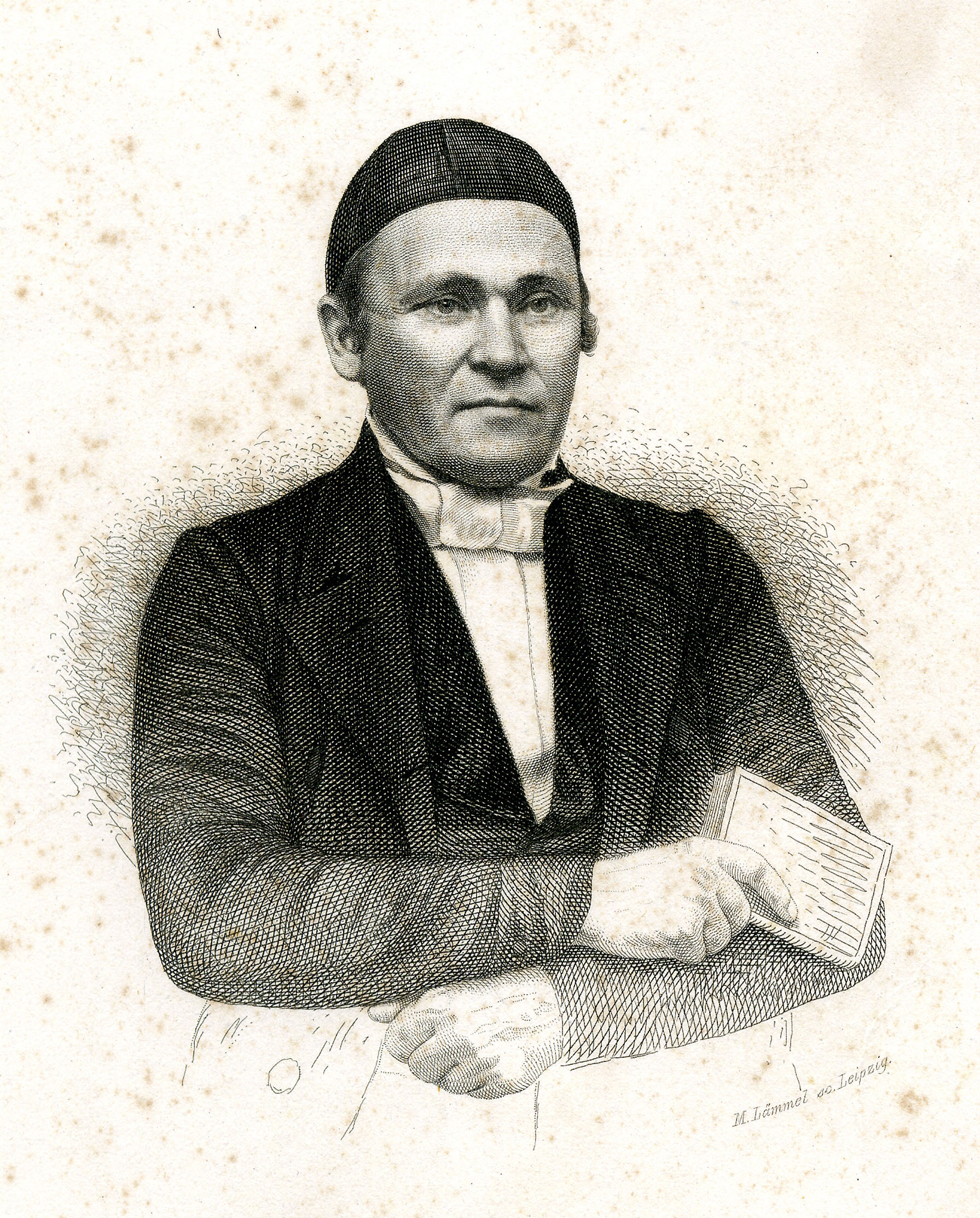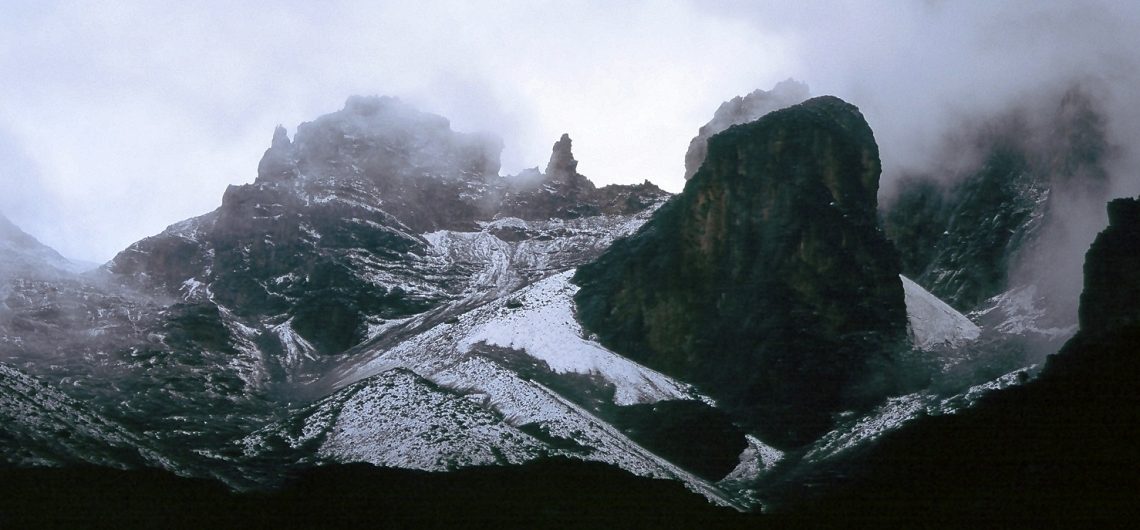Johann Ludwig Krapf was the first European to view the mountain (1849), and it was only partially scaled by the British geologist John Walter Gregory and the Hungarian adventurer Sámuel, Gróf (count) Teleki in the 1880s (1893). Together with the Swiss mountain guides César Ollier and Joseph Brocherel, the British geographer Halford John Mackinder was the first to summit Kilimanjaro in 1899 by climbing all the way to the peak. At the northwest foot of the mountain is the town of Nanyuki, which is about 120 miles (190 km) north of Nairobi by train and serves as a major ascension base together with Naro Moru (to the west). Before Krapf stumbled on Mount Kenya, no other non-local had scaled this Kenyan mountain to the peak.
Krapf Rognon (4,899m) on Mount Kenya is named after Johann Ludwig Krapf in his honour. It is a rounded and rocky hump that lies below the Nelion Peak on the North East side of the mountain. Climbing the Krapf Rognon is harder than climbing the Barranco Wall on Kilimanjaro because you need crampons to navigate this rock on Mount Kenya.
Johann Ludwig Krapf was a German explorer and missionary who was one of the first Europeans to visit the region around Mount Kenya. He is best known for his work as a missionary in East Africa, where he was among the first Europeans to explore the region and learn about the local cultures and languages. He is also known for his work as a linguist, and he was the first person to transcribe many of the languages spoken in East Africa. Despite his many accomplishments, Krapf is also known to have been the first non-local person to see Mount Kenya.
The 1800s were a crazy century judging by how people were discovering and stumbling up landmarks, countries, and scientific inventions. This is highly attributed to the huge exodus of missionaries to spread the gospel in “never-heard-before” territories.

Who was Johann Ludwig Krapf
German missionary Johann Ludwig Krapf, who lived from 11 January 1810 to 26 November 1881, was also an adventurer, linguist, and traveler. Krapf was a key player in Johannes Rebmann’s exploration of East Africa. Through the assistance of the Akamba who lived on its slopes and Kilimanjaro, they became the first Europeans to visit Mount Kenya. In 1849 and 1850, Ludwig Krapf traveled to Ukambani, the Kamba people’s ancestral home. He was able to correctly translate the Bible into Kamba. At particular in Mombasa, Krapf was crucial to the exploration of the East African shoreline.
He translated the bible into the Swahili language.
Johann Ludwig Krapf, a German Lutheran working for the Anglican Church Missionary Society, was not only the first modern missionary in East Africa but also a trailblazer in the translation of the Bible into Swahili and other languages. Later, Bishop Edward Steere of Zanzibar released the Swahili translation of the New Testament and the full Bible in 1891. Steere’s Swahili Bible served as a foundation for Bible translations into other East African vernaculars, and the early missionaries Ludwig Krapf, Bishop Steere, and Father Sacleux set a high bar for Swahili scholars.
Tanzania to set up a Swahili poster on top of Kilimanjaro to celebrate independence day.
His Journey into Kenya
Krapf lived in Alexandria, Egypt for a while, when he was married. In an effort to reach the Oromo from what is now the Kenyan coast, he then left for East Africa. The Zanzibar sultanate at the time ruled over the majority of East Africa’s coastline. He received permission from Sultan Sayyid Said to establish a mission station at Mombasa, a seaside city. Krapf re-started by studying the native Mijikenda language as well as Swahili, the common language of communication in East Africa.
Read about the Kikuyu tribe of Mount Kenya region
His wife and little daughter contracted malaria soon after their arrival in Mombasa and passed away as a result. Krapf established his station New Rabai in the upper Rabai grounds on the coastal slopes (Rabai Mpya).
He created the first Swahili dictionary and grammar here. Additionally, he began learning additional African languages, creating dictionaries, and translating passages of Scripture. He transcribed Genesis with the aid of a Muslim judge named Ali bin Modehin. He continued by translating the Book of Common Prayer and the New Testament. Although it was eventually utilized to revise a translation into a more southern dialect of Swahili, the majority of this research remained unpublished.
Johannes Rebmann, a fellow southwest German Lutheran working for the CMS, joined him in 1846. The first Europeans to discover the snow-capped slopes of Kilimanjaro and Mount Kenya were Krapf and Rebmann, who set out to explore the interior of East Africa.
They sent reports on them to Europe, and the experts laughed them off.
In 1853, Krapf had to return to Germany due to his failing health. The Book of the Battle of Tambuka, the first Swahili manuscript, and other antiquated Swahili manuscripts were among the items he carried with him. He continued his language research and consultancy work for Christian missions in Korntal.
Who was the first explorer to discover Mount Kenya?
Johann Ludwig Krapf, a German missionary, ethnologist, and adventurer, was the first European to discover the peak. From Kitui, a city 160 kilometers to the east of Nairobi, Krapf first saw the mountain/peak in 1849. Krapf’s associate made the initial discovery of Mount Kilimanjaro a year earlier.
Finding the origin of the rivers that flowed from the direction of the mountain seemed like it may be intriguing to Krapf. He thought it may be the supposed source of the White Nile. Krapf came back two years later and approached Mount Kenya a little more closely, but he didn’t get far enough to learn anymore.
Johan Maria Hildebrandt, a German botanist, visited Africa on multiple occasions in the late 19th century.
Between 1873 and 1874, he traveled to Somaliland, Yemen, and Eritrea. He left for Mount Kenya on January 10, 1877, through the routes Ndara, Ndi, and Kitui. In the vicinity, he gathered many snail species.
He never set out with an expeditionary goal in mind; merely a scientific one. He said, “It was my responsibility to harvest this same grass, while these other explorers press restlessly forward and, as it were, do not let the grass grow under their feet.” He made thorough notes about several undiscovered creatures and plants.
Hildebrandt never visited the mountain, despite hearing numerous tales about it. But Mount Kenya has started to catch the eye of other tourists.
![]()


Comments